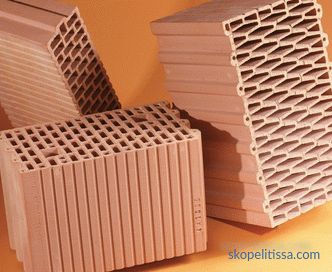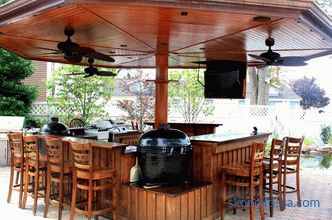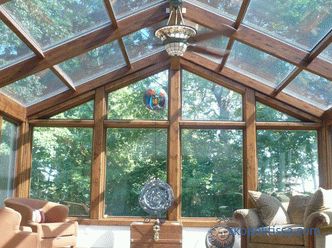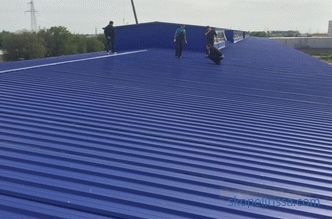The architectural decor is able to give the facade individuality and make it elegant and memorable. The article tells about the decoration of the corners of the house, the functions of decorative paneling and its use for various facades. You will learn about what natural and modern materials are used for rustic decor, get acquainted with the features of the installation of rust.
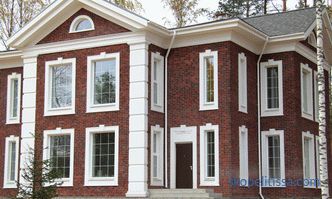
Decorative decoration of the corners of various facades
Facade decoration is an important part of the design of suburban housing ; its role is to give the house a complete look. Finishing the corners of the house outside is one of the main types of work; the method of finishing often depends on the type of material used for wall cladding.
Corner treatment is often done with brick, stone, tile, and plaster. Finishing the external corners of wet facades (plaster) is carried out using special perforated plaster elements - PVC corner facade profiles, equipped with a reinforcing mesh. Such corners play an important role in strengthening the wet-type facade.
If your house is covered with siding (or another type of panel), the task of finishing the corners of the facade is simplified. The panel includes special finishing (shaped) elements, which, as a rule, are made of galvanized steel with polymer coating. For closing the outer corners of the facade is intended corner (outer corner), performing several functions simultaneously:
-
Decorative . Registration of joints of panels in the chosen style.
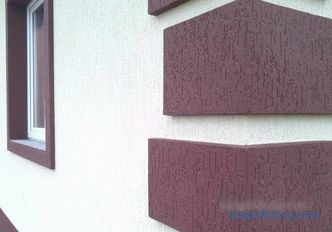
-
Work . Corners serve as guides for siding, fix the panel. Details are mounted on the batten using a level.
-
Protective . The ends of the panels are protected from accidental mechanical loads.
It is believed that wooden walls do not require external design of corners, because the ends are strong enough and have an attractive natural look. However, it is the end parts that are the most vulnerable areas, primarily suffering from atmospheric moisture. To protect the corners of the wooden structure, they are subjected to the following operations:
-
Grinding . It is used to clean the surface of the timber or log from the remnants of the bark and give the cut a well-groomed look. The operation also removes small surface cracks, thereby increasing the strength of the material.
-
Protection . To prevent the walls from falling prematurely, three types of protection are used - antiseptic (against mold and parasites), moisture and fire resistant. The choice of options is huge, you can use liquid impregnations, spray bottles, special sealants.
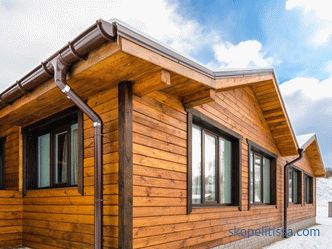
-
Finishing . It is not always needed: if the log house is made without residue (with closed corners), only polishing and treatment with protective compounds will be required. Sometimes the corners try to emphasize and deliberately leave them open. In other cases, decorative overlays on the corners are made (most often they are made of plastic for wood). Such linings not only decorate and protect, but also provide additional warming.
Decorating the corners of the facade with rust
The classic method of finishing the corners of a house is a rust stone. Rust as a designer's reception was widely spread in Petrine time. Then, not only the corners of the facades of the buildings were finished, but also the door or window openings, as well as the basement. In modern private construction they also use various elements of decor, including interfloor belts, moldings and cornices, window locks and brackets.
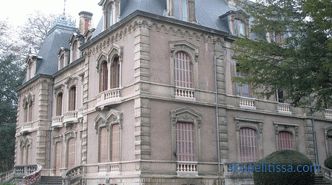
On our website you can find contacts of construction companies that offer the service of designing country houses. You can directly communicate with representatives by visiting the low-rise country exhibition.
However, the natural rusty stone remains the most famous decoration technique, thanks to which the structure takes on an exquisite-aristocratic look. Rustic corners of natural stone have the following advantages:
-
Physical properties . They are distinguished by mechanical strength and resistance to environmental factors (frost, rain, sun).
-
Quality . Retain the original properties for decades.
-
External attractiveness . Natural stone trim always looks decent, preserves the texture and richness of shades throughout the entire life cycle.
The stone for facing the walls and corners of the house is chosen based on color, texture and other qualities. Common types include the following types of stone:
-
Sandstone, shell rock, limestone .Breeds are popular due to their low cost, moisture resistance and good density; The sandstone remains the leader, because of its special frost resistance. When choosing a wide range of materials is also important, from bright white to dark brown. The rustic finish with these stones gives the house an old, majestic look.
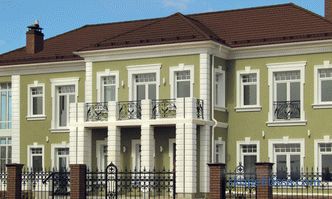
-
Dolomite and travertine . Rusty of these rocks have a premium quality, excellent density, special texture. The color palette, which depends on the place of extraction of the stone, has a special refinement and allows you to choose more rare shades - creamy-beige, greenish, aqua. The high strength and wear resistance of dolomite allows it to be used for facing the basement.
-
Granite and marble . The most durable, durable and expensive materials. They rarely veneer the entire facade, but often used for decorating corners, window openings and entrance groups.
Regardless of which architectural style a country house belongs to, and which stone was preferred, natural beauty and texture of the material will be a harmonious addition and decoration of the facade.
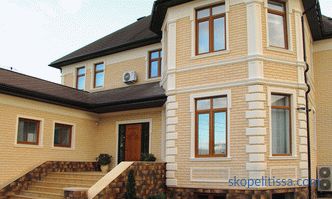
On our site you can find contacts of construction companies that offer turnkey country house building services. You can directly communicate with representatives by visiting the low-rise country exhibition.
Natural stone is a classic of facade decoration, but in modern conditions its use is not always practical and convenient. Often the aesthetic component outweighs the complexity of installation, a hefty load on the load-bearing walls, an exorbitant budget. It is logical that decors with other properties are widely used in modern construction. New technological materials have become popular among designers, decorators and architects due to their low weight and other useful features.
About the production of facade decor in the following video:
Easy solution for rusting
Today, decorative decoration of the corners of the house outside is done with using lightweight materials. The most budget option offered by manufacturers is products from expanded polystyrene with a protective coating. The material reliably imitates natural stone and stucco, easy to handle and care. When choosing this material, you should take into account not only its merits, but also be mindful of the shortcomings, including:
-
Shortness of . The material is a mesh-reinforced foam plastic that does not tolerate frosts, readily burns with the release of toxic substances and is destroyed in the presence of some technical liquids.
-
Low mechanical resistance . Foam plastic parts are easily crushed, because of which the front corners after a season or two can have a very unaesthetic appearance due to sloppy (or too curious) offsprings.
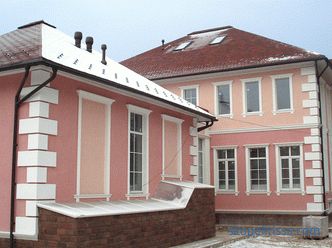
A much more promising option is high density polyurethane products . Light facade decoration (including rust), which adorns most of the European and American buildings, is made of polyurethane. Rust stones (another name is bosses), made of this material, are not much more expensive than analogues of expanded polystyrene, but have different properties:
-
High density and durability .
-
Frost resistance .
-
Easy installation (you don’t have to drill through the corner of the house).
-
Practicality . Unlike stone rusts, products from expanded polystyrene can be removed without serious consequences. You can change the style of the facade without serious investments.
About the secrets of beautiful finishes in the following video:
On our site you can find contacts of construction companies that offer construction service of small architectural forms. You can directly communicate with representatives by visiting the low-rise country exhibition.
Rust from polymer concrete
The material for the facade decor can be polymer concrete (artificial stone, architectural concrete). The composition of this type of concrete includes synthetic additives (eg, acrylic) and finely divided natural filler, crushed quartz or granite chips. Polymer concrete has the following set of characteristics:
-
Durability . High strength, moisture resistance and resistance to low temperatures. Service life reaches 25 years or more.
-
Low weight . The elements are mounted even on the ventilated facade.
-
Variety . From polymer concrete make decor of any shape and appearance.Finishing corners can look like natural stone, smooth or torn brick, plastered surface.
The disadvantages include the inability of polymer concrete products to withstand a high load carrying capacity, which is explained by the large volume of filler in the composition; Rust stones of polymer concrete cannot serve as a supporting element. Another feature of the material is that it is impossible to make small parts from it, which, however, is not critical for finishing corners.
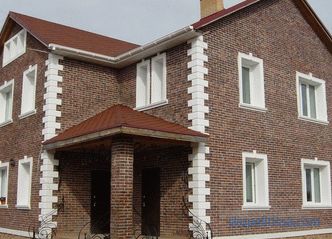
Features of facing the corners of the facade
Located in the corners of the building, rusty stones give it a clear geometric shape. The installation of rustic decor obeys the following rules:
-
The sequence . Used straight, checkerboard and variable method of laying. In some cases, the rustic stone finish may have a smooth, fantasy shape.
-
Location . Corner rusty panels without chamfer (bevel) on the surface are allowed to be laid without a gap; This allows you to simplify and accelerate the facade work. Angle rusting with a chamfer can be installed with or without a gap, at the choice of the customer. The gaps between the elements can be from 30 to 60 mm.
-
Attachment . Rust stone is fastened in different ways, from the use of special glue to the organization of powerful fastenings for rust made from natural stone.
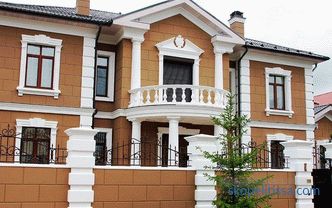
It might be interesting! B The article on the following link read about the facade panels under the tree for exterior plating.
Modern ways of finishing corners
Working with corners (especially if stone is used) requires accuracy and the presence of specific skills and experience of the performer. In modern private construction, even stone rusts serve only for decoration. Nevertheless, they make the facade heavier and need reinforced fastening, and it will not be possible to replace them.
The task is greatly simplified when using lightweight panels; for this purpose, a corner trimming system has been developed, the installation of which is carried out according to the principle of siding and facade panels. For mounting the panels at the corners, it is better to use a metal batten, since in the corners the mechanical load always acts stronger than on the plane of the walls. Finishing the corners goes through the following steps:
-
Mounting the mounting base-profile using self-tapping screws.
-
Rustic panels are superimposed on the base : every detail is inserted into the groove and snaps into place.
-
Subtleties of installation . The order of installation of rust panels (sequence and symmetry of the location) must be thought out in advance; You cannot rearrange the elements, as the fastening mechanism is designed for single use.
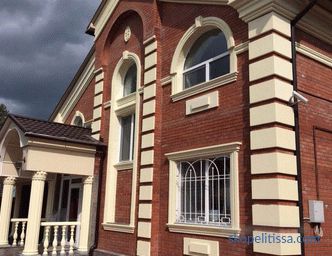
-
Between rust and crate remains a gap where front panels (or a siding) refuel. If the front material is thicker than the gap, the mounting shelf is used for fastening.
-
This finishing system can be used and with plastered facades ; in this case, the mounting shelf from the profile is cut off.
It may be interesting! In the article on the following link read about the house-hut in the suburbs of Berlin.
Conclusion
Today, rustic stones are in demand as a relatively economical and easy way to create a clear image of a building, while at the same time emphasizing style and personality. A light artificial substitute from polymer concrete, polyurethane or expanded polystyrene came to replace the heavy and expensive natural stone, and the protective finish turned into decorative. Rusty panels, combined in an angular vertical structure, adorn a variety of facades - siding, brickwork, plaster.
